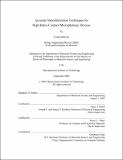| dc.contributor.advisor | Henry I. Smith and Harry L. Tuller. | en_US |
| dc.contributor.author | Barwicz, Tymon | en_US |
| dc.contributor.other | Massachusetts Institute of Technology. Dept. of Materials Science and Engineering. | en_US |
| dc.date.accessioned | 2006-06-20T12:53:05Z | |
| dc.date.available | 2006-06-20T12:53:05Z | |
| dc.date.copyright | 2005 | en_US |
| dc.date.issued | 2005 | en_US |
| dc.identifier.uri | http://hdl.handle.net/1721.1/33169 | |
| dc.description | Thesis (Ph. D.)--Massachusetts Institute of Technology, Dept. of Materials Science and Engineering, 2005. | en_US |
| dc.description | This electronic version was submitted by the student author. The certified thesis is available in the Institute Archives and Special Collections. | en_US |
| dc.description | Includes bibliographical references (p. 195-199). | en_US |
| dc.description.abstract | High-refractive-index-contrast microphotonic devices provide strong light confinement allowing for sharp waveguide bends and small dielectric optical resonators. They allow dense optical integration and unique applications to optical filters and sensors but present exceptional complications in design and fabrication. In this work, nanofabrication techniques are developed to address the two main challenges in fabrication of high-index contrast microphotonic devices: sidewall roughness and dimensional accuracy. The work focuses on fabrication of optical add-drop filters based on high-index contrast microring-resonators. The fabrication is based on direct-write scanning-electronbeam lithography. A sidewall-roughness characterization and optimization scheme is developed as is the first three-dimensional analysis of scattering losses due to sidewall roughness. Writing strategy in scanning-electron-beam lithography and absolute and relative dimensional control are addressed. The nanofabrication techniques developed allowed fabrication of the most advanced microring add-drop-filters reported in the literature. The sidewall-roughness standard deviation was reduced to 1.6 nm. | en_US |
| dc.description.abstract | (cont.) The field polarization and the waveguide cross-sections minimizing scattering losses are presented. An absolute dimensional control accuracy of 5 nm is demonstrated. Microring resonators with average ring-waveguide widths matched to 26 pm to a desired relative width-offset are reported. | en_US |
| dc.description.statementofresponsibility | by Tymon Barwicz. | en_US |
| dc.format.extent | 199 p. | en_US |
| dc.format.extent | 25552478 bytes | |
| dc.format.extent | 25552006 bytes | |
| dc.format.mimetype | application/pdf | |
| dc.format.mimetype | application/pdf | |
| dc.language.iso | eng | en_US |
| dc.publisher | Massachusetts Institute of Technology | en_US |
| dc.rights | M.I.T. theses are protected by copyright. They may be viewed from this source for any purpose, but reproduction or distribution in any format is prohibited without written permission. See provided URL for inquiries about permission. | en_US |
| dc.rights.uri | http://dspace.mit.edu/handle/1721.1/7582 | |
| dc.subject | Materials Science and Engineering. | en_US |
| dc.title | Accurate nanofabrication techniques for high-index-contrast microphotonic devices | en_US |
| dc.type | Thesis | en_US |
| dc.description.degree | Ph.D. | en_US |
| dc.contributor.department | Massachusetts Institute of Technology. Department of Materials Science and Engineering | |
| dc.identifier.oclc | 64387666 | en_US |
